RENAULT MEGANE 2005 X84 / 2.G Owners Manual
Manufacturer: RENAULT, Model Year: 2005, Model line: MEGANE, Model: RENAULT MEGANE 2005 X84 / 2.GPages: 250, PDF Size: 5.72 MB
Page 181 of 250
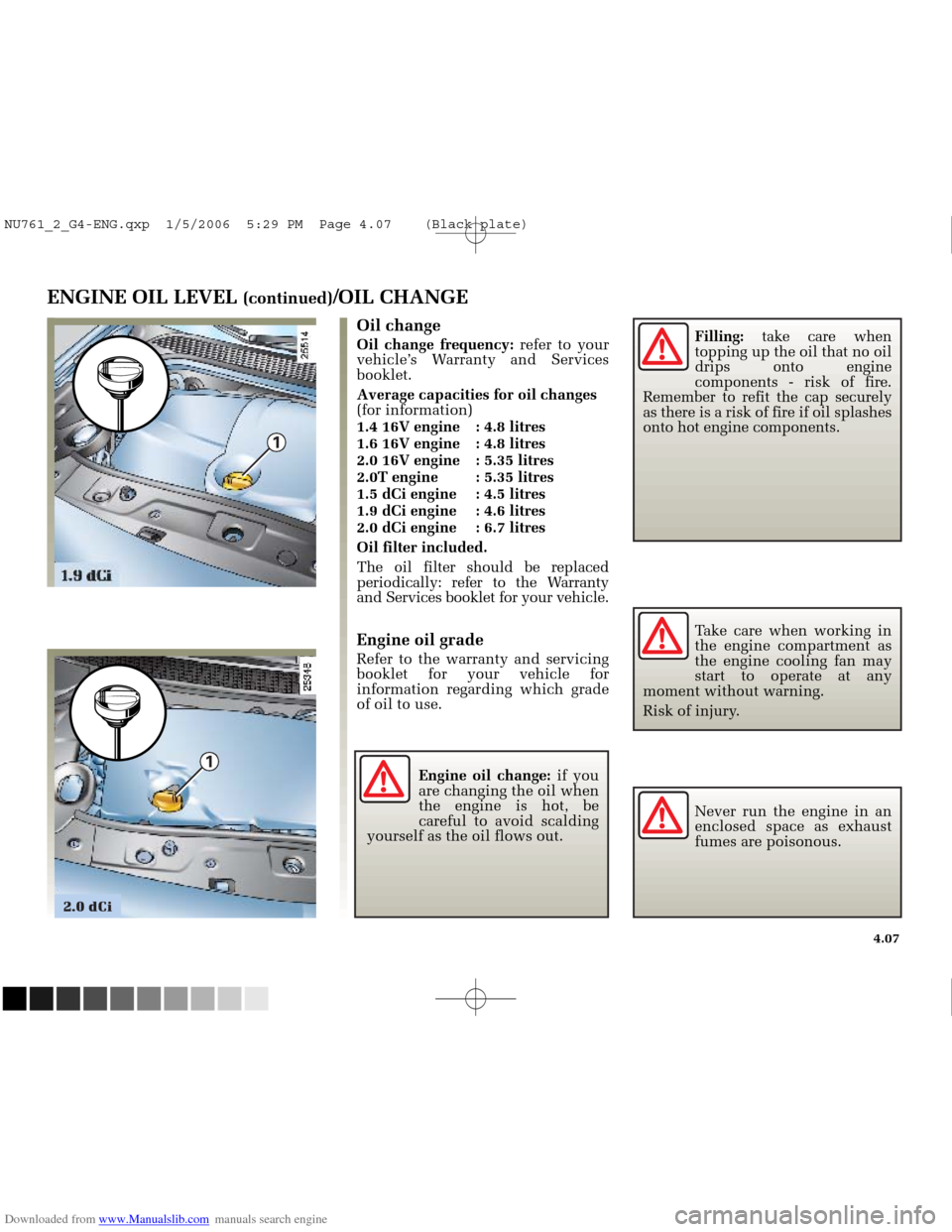
Downloaded from www.Manualslib.com manuals search engine
1
2.0 dCi
1
NU761_2_G4-FRA.qxd 14/11/05 10:11 Page 4.07
4.07
ENGINE OIL LEVEL (continued)/OIL CHANGE
Oil change
Oil change frequency: refer to your
vehicle’s Warranty and Services
booklet.
Average capacities for oil changes
(for information)
1.4 16V engine : 4.8 litres
1.6 16V engine : 4.8 litres
2.0 16V engine : 5.35 litres
2.0T engine : 5.35 litres
1.5 dCi engine : 4.5 litres
1.9 dCi engine : 4.6 litres
2.0 dCi engine : 6.7 litres
Oil filter included.
The oil filter should be replaced
periodically: refer to the Warranty
and Services booklet for your vehicle.
Engine oil grade
Refer to the warranty and servicing
booklet for your vehicle for
information regarding which grade
of oil to use.
Engine oil change: if you
are changing the oil when
the engine is hot, be
careful to avoid scalding
yourself as the oil flows out. Never run the engine in an
enclosed space as exhaust
fumes are poisonous. Take care when working in
the engine compartment as
the engine cooling fan may
start to operate at any
moment without warning.
Risk of injury. Filling:
take care when
topping up the oil that no oil
drips onto engine
components - risk of fire.
Remember to refit the cap securely
as there is a risk of fire if oil splashes
onto hot engine components.
NU761_2_G4-ENG.qxp 1/5/2006 5:29 PM Page 4.07 (Black plate)
Page 182 of 250
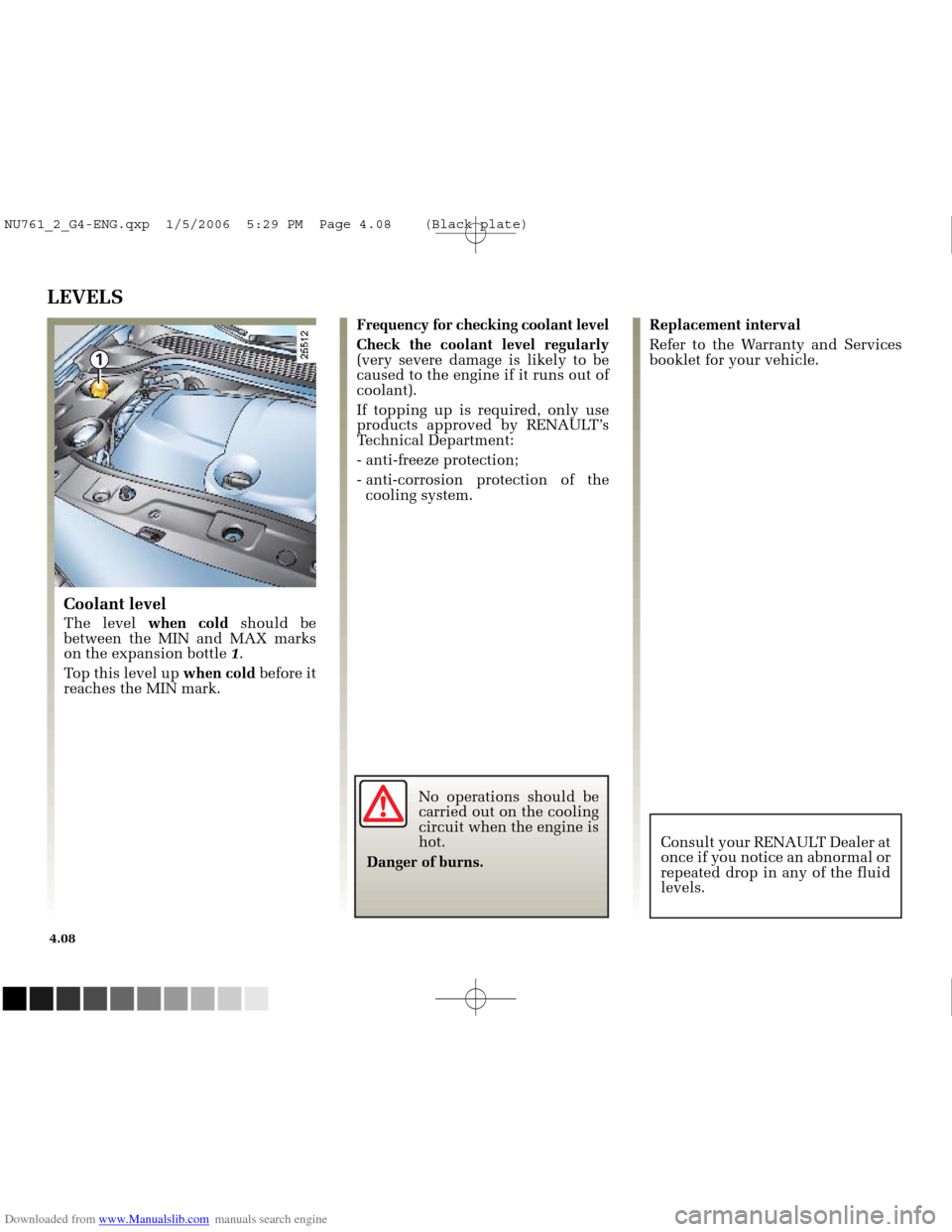
Downloaded from www.Manualslib.com manuals search engine
1
NU761_2_G4-FRA.qxd 14/11/05 10:11 Page 4.08
4.08
LEVELS
Frequency for checking coolant level
Check the coolant level regularly
(very severe damage is likely to be
caused to the engine if it runs out of
coolant).
If topping up is required, only use
products approved by RENAULT’s
Technical Department:
- anti-freeze protection;
- anti-corrosion protection of thecooling system. Replacement interval
Refer to the Warranty and Services
booklet for your vehicle.
Coolant level
The level
when cold should be
between the MIN and MAX marks
on the expansion bottle 1.
Top this level up when coldbefore it
reaches the MIN mark.
Consult your RENAULT Dealer at
once if you notice an abnormal or
repeated drop in any of the fluid
levels.
No operations should be
carried out on the cooling
circuit when the engine is
hot.
Danger of burns.
NU761_2_G4-ENG.qxp 1/5/2006 5:29 PM Page 4.08 (Black plate)
Page 183 of 250
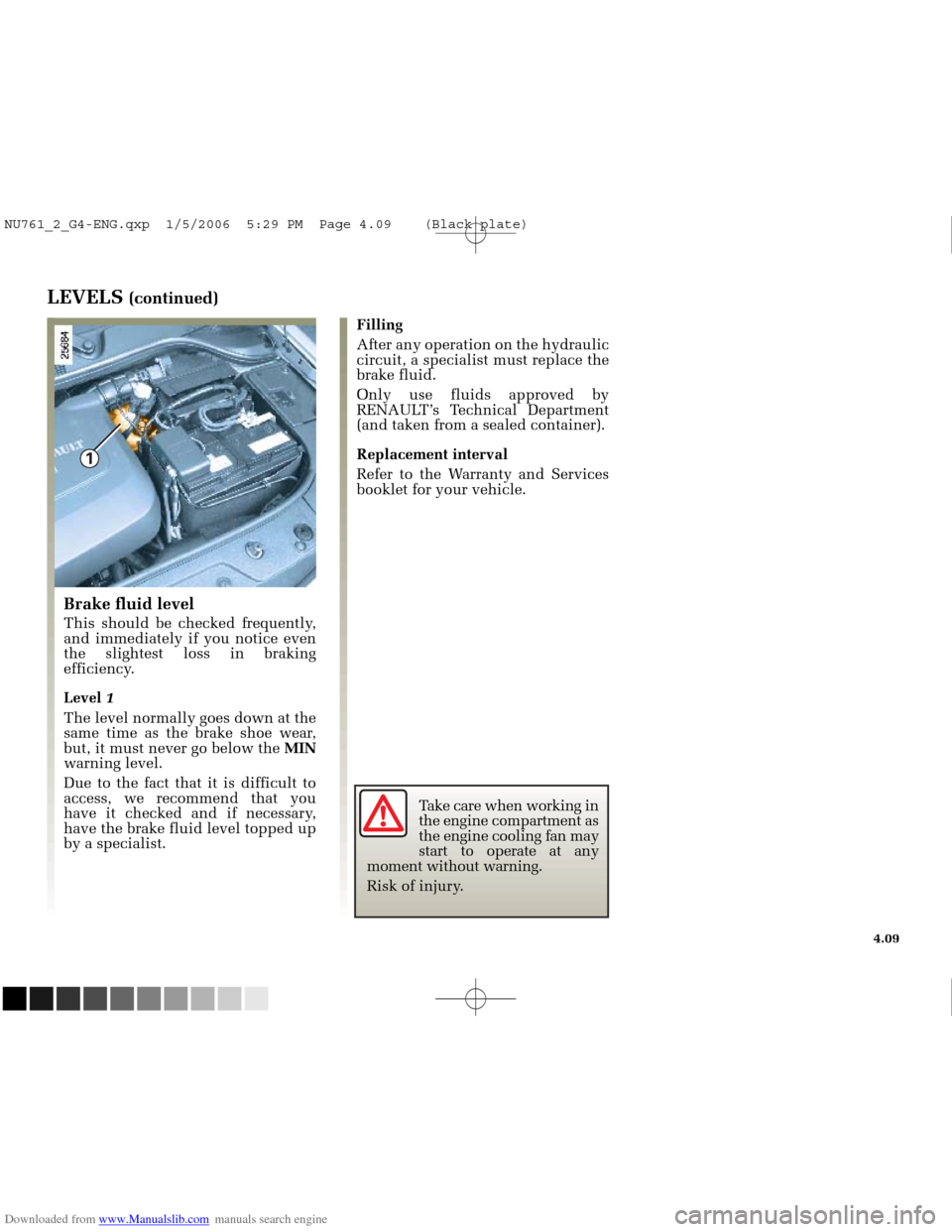
Downloaded from www.Manualslib.com manuals search engine
1
NU761_2_G4-FRA.qxd 14/11/05 10:11 Page 4.09
4.09
LEVELS (continued)
Brake fluid level
This should be checked frequently,
and immediately if you notice even
the slightest loss in braking
efficiency.
Level 1
The level normally goes down at the
same time as the brake shoe wear,
but, it must never go below the MIN
warning level.
Due to the fact that it is difficult to
access, we recommend that you
have it checked and if necessary,
have the brake fluid level topped up
by a specialist. Filling
After any operation on the hydraulic
circuit, a specialist must replace the
brake fluid.
Only use fluids approved by
RENAULT’s Technical Department
(and taken from a sealed container).
Replacement interval
Refer to the Warranty and Services
booklet for your vehicle.
Take care when working in
the engine compartment as
the engine cooling fan may
start to operate at any
moment without warning.
Risk of injury.
NU761_2_G4-ENG.qxp 1/5/2006 5:29 PM Page 4.09 (Black plate)
Page 184 of 250
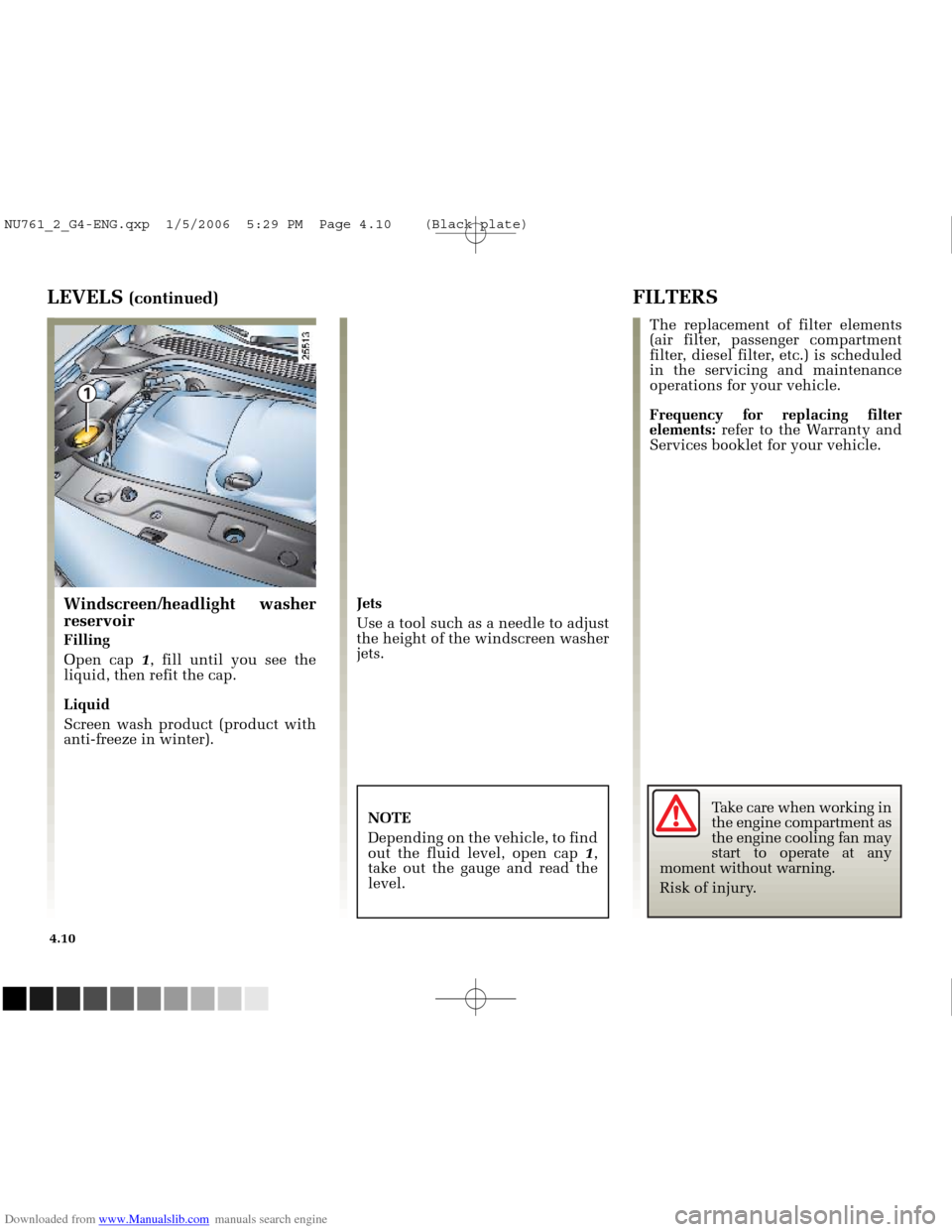
Downloaded from www.Manualslib.com manuals search engine
1
NU761_2_G4-FRA.qxd 14/11/05 10:11 Page 4.10
4.10
LEVELS (continued)FILTERS
The replacement of filter elements
(air filter, passenger compartment
filter, diesel filter, etc.) is scheduled
in the servicing and maintenance
operations for your vehicle.
Frequency for replacing filter
elements: refer to the Warranty and
Services booklet for your vehicle.
Windscreen/headlight washer
reservoir
Filling
Open cap 1, fill until you see the
liquid, then refit the cap.
Liquid
Screen wash product (product with
anti-freeze in winter). Jets
Use a tool such as a needle to adjust
the height of the windscreen washer
jets.
NOTE
Depending on the vehicle, to find
out the fluid level, open cap 1,
take out the gauge and read the
level.
Take care when working in
the engine compartment as
the engine cooling fan may
start to operate at any
moment without warning.
Risk of injury.
NU761_2_G4-ENG.qxp 1/5/2006 5:29 PM Page 4.10 (Black plate)
Page 185 of 250
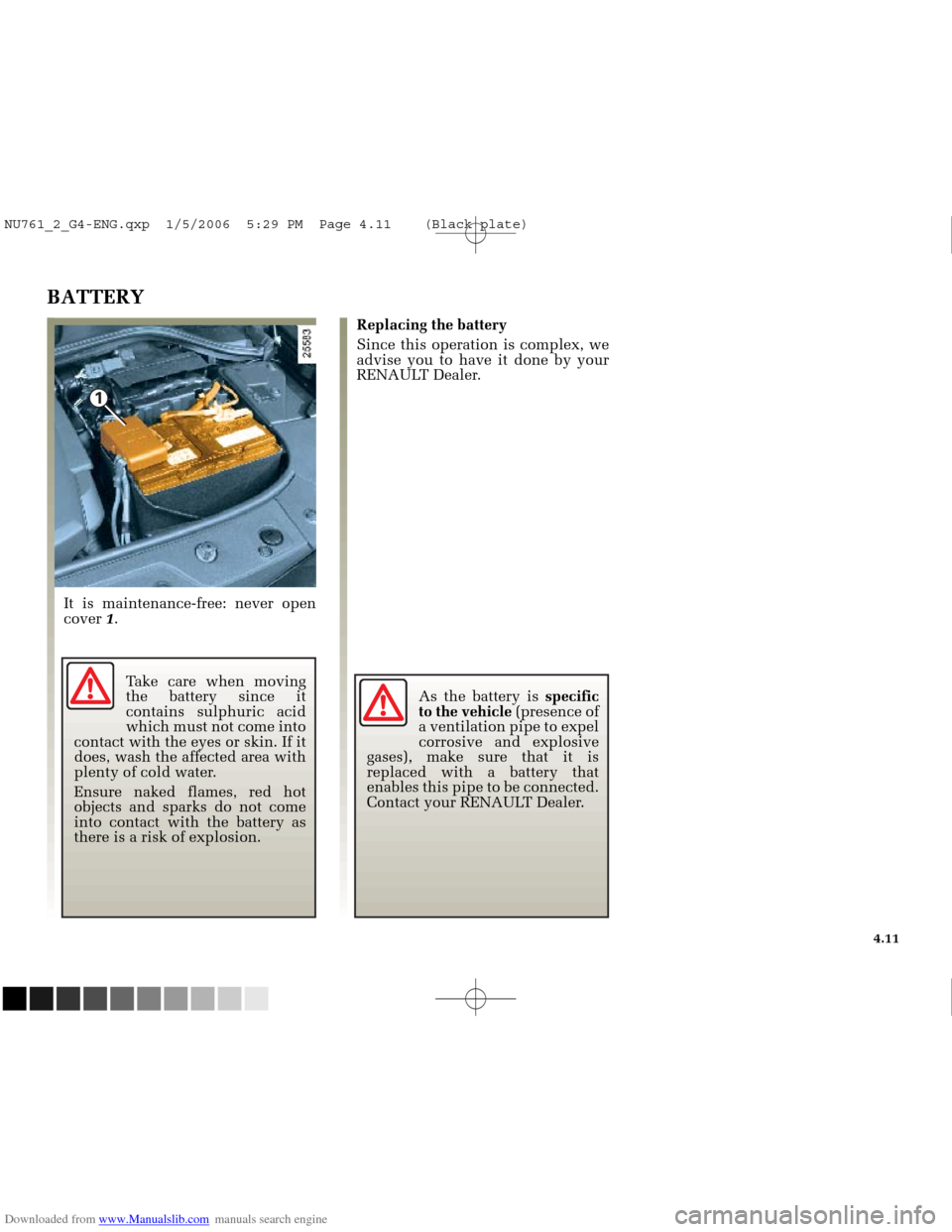
Downloaded from www.Manualslib.com manuals search engine
1
NU761_2_G4-FRA.qxd 14/11/05 10:11 Page 4.11
4.11
BATTERY
It is maintenance-free: never open
cover 1. Replacing the battery
Since this operation is complex, we
advise you to have it done by your
RENAULT Dealer.
Take care when moving
the battery since it
contains sulphuric acid
which must not come into
contact with the eyes or skin. If it
does, wash the affected area with
plenty of cold water.
Ensure naked flames, red hot
objects and sparks do not come
into contact with the battery as
there is a risk of explosion. As the battery is
specific
to the vehicle (presence of
a ventilation pipe to expel
corrosive and explosive
gases), make sure that it is
replaced with a battery that
enables this pipe to be connected.
Contact your RENAULT Dealer.
NU761_2_G4-ENG.qxp 1/5/2006 5:29 PM Page 4.11 (Black plate)
Page 186 of 250
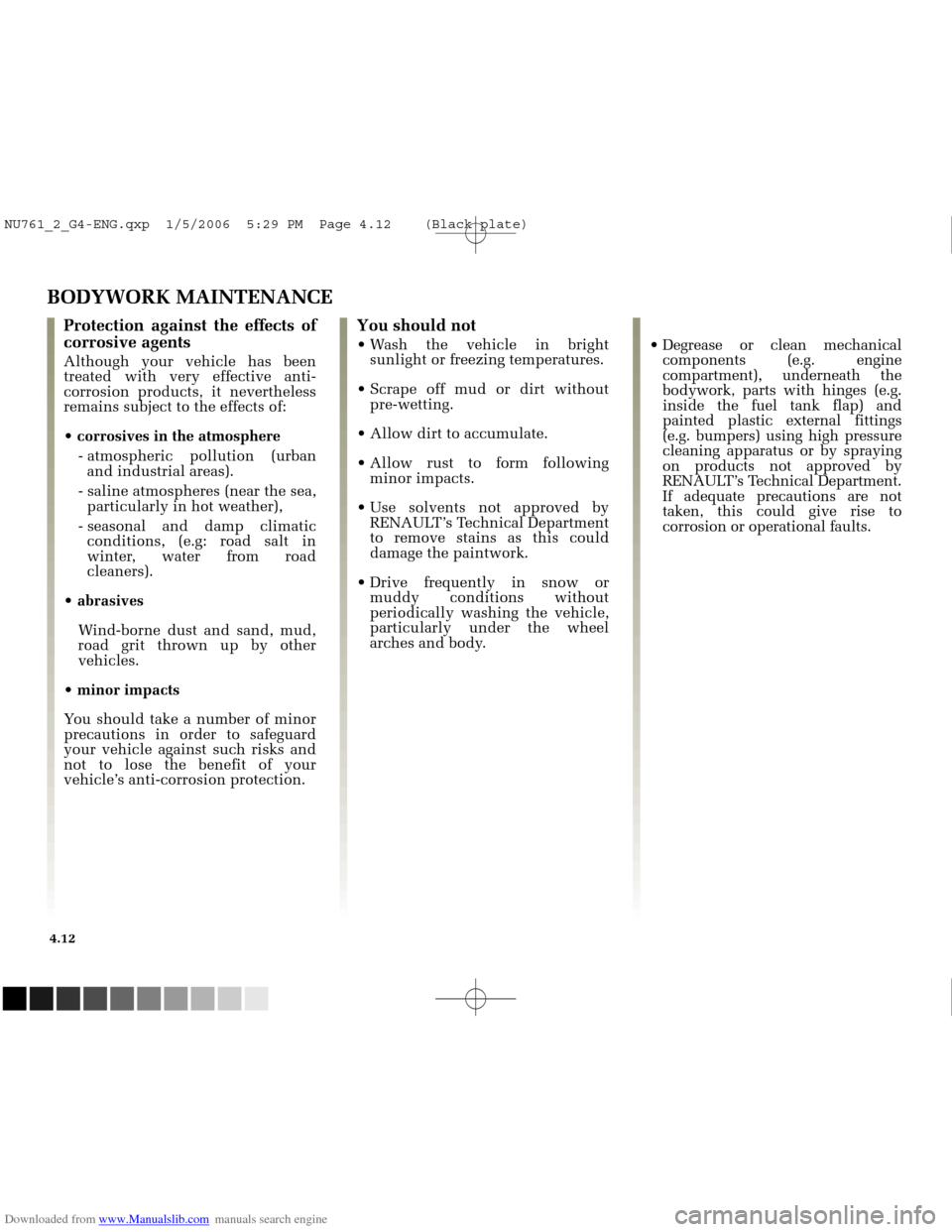
Downloaded from www.Manualslib.com manuals search engine
NU761_2_G4-FRA.qxd 14/11/05 10:11 Page 4.12
4.12
BODYWORK MAINTENANCE
Protection against the effects of
corrosive agents
Although your vehicle has been
treated with very effective anti-
corrosion products, it nevertheless
remains subject to the effects of:
• corrosives in the atmosphere- atmospheric pollution (urbanand industrial areas).
- saline atmospheres (near the sea, particularly in hot weather),
- seasonal and damp climatic conditions, (e.g: road salt in
winter, water from road
cleaners).
abrasives Wind-borne dust and sand, mud,
road grit thrown up by other
vehicles.
minor impacts
You should take a number of minor
precautions in order to safeguard
your vehicle against such risks and
not to lose the benefit of your
vehicle’s anti-corrosion protection.
You should not
Wash the vehicle in bright
sunlight or freezing temperatures.
Scrape off mud or dirt without
pre-wetting.
Allow dirt to accumulate.
Allow rust to form following
minor impacts.
Use solvents not approved by
RENAULT’s Technical Department
to remove stains as this could
damage the paintwork.
Drive frequently in snow or
muddy conditions without
periodically washing the vehicle,
particularly under the wheel
arches and body.
Degrease or clean mechanical
components (e.g. engine
compartment), underneath the
bodywork, parts with hinges (e.g.
inside the fuel tank flap) and
painted plastic external fittings
(e.g. bumpers) using high pressure
cleaning apparatus or by spraying
on products not approved by
RENAULT’s Technical Department.
If adequate precautions are not
taken, this could give rise to
corrosion or operational faults.
NU761_2_G4-ENG.qxp 1/5/2006 5:29 PM Page 4.12 (Black plate)
Page 187 of 250
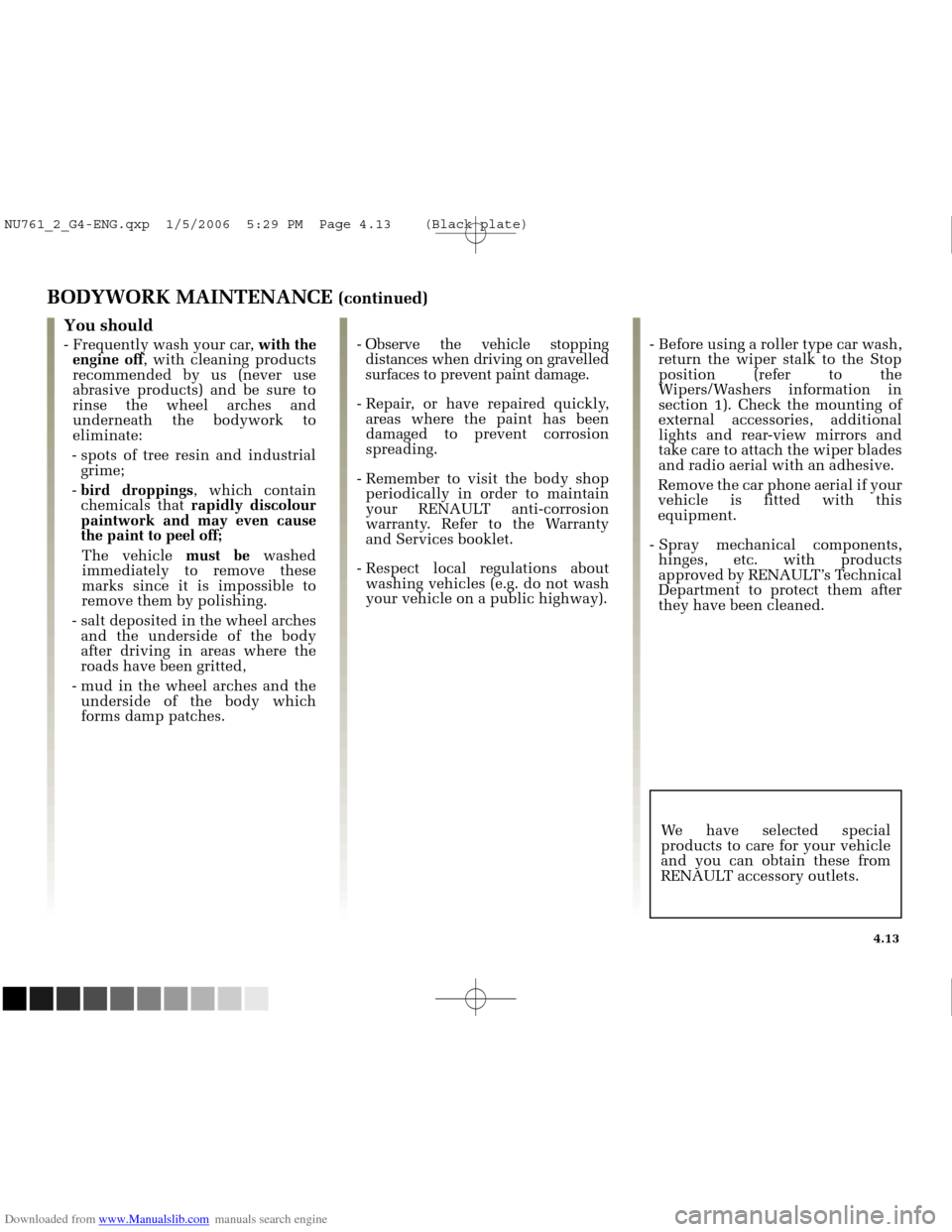
Downloaded from www.Manualslib.com manuals search engine
NU761_2_G4-FRA.qxd 14/11/05 10:11 Page 4.13
4.13
BODYWORK MAINTENANCE (continued)
You should
- Frequently wash your car, with the
engine off , with cleaning products
recommended by us (never use
abrasive products) and be sure to
rinse the wheel arches and
underneath the bodywork to
eliminate:
- spots of tree resin and industrial grime;
- bird droppings , which contain
chemicals that rapidly discolour
paintwork and may even cause
the paint to peel off;
The vehicle must bewashed
immediately to remove these
marks since it is impossible to
remove them by polishing.
- salt deposited in the wheel arches and the underside of the body
after driving in areas where the
roads have been gritted,
- mud in the wheel arches and the underside of the body which
forms damp patches. - Observe the vehicle stopping
distances when driving on gravelled
surfaces to prevent paint damage.
- Repair, or have repaired quickly, areas where the paint has been
damaged to prevent corrosion
spreading.
- Remember to visit the body shop periodically in order to maintain
your RENAULT anti-corrosion
warranty. Refer to the Warranty
and Services booklet.
- Respect local regulations about washing vehicles (e.g. do not wash
your vehicle on a public highway). - Before using a roller type car wash,
return the wiper stalk to the Stop
position (refer to the
Wipers/Washers information in
section 1). Check the mounting of
external accessories, additional
lights and rear-view mirrors and
take care to attach the wiper blades
and radio aerial with an adhesive.
Remove the car phone aerial if your
vehicle is fitted with this
equipment.
- Spray mechanical components, hinges, etc. with products
approved by RENAULT’s Technical
Department to protect them after
they have been cleaned.
We have selected special
products to care for your vehicle
and you can obtain these from
RENAULT accessory outlets.
NU761_2_G4-ENG.qxp 1/5/2006 5:29 PM Page 4.13 (Black plate)
Page 188 of 250
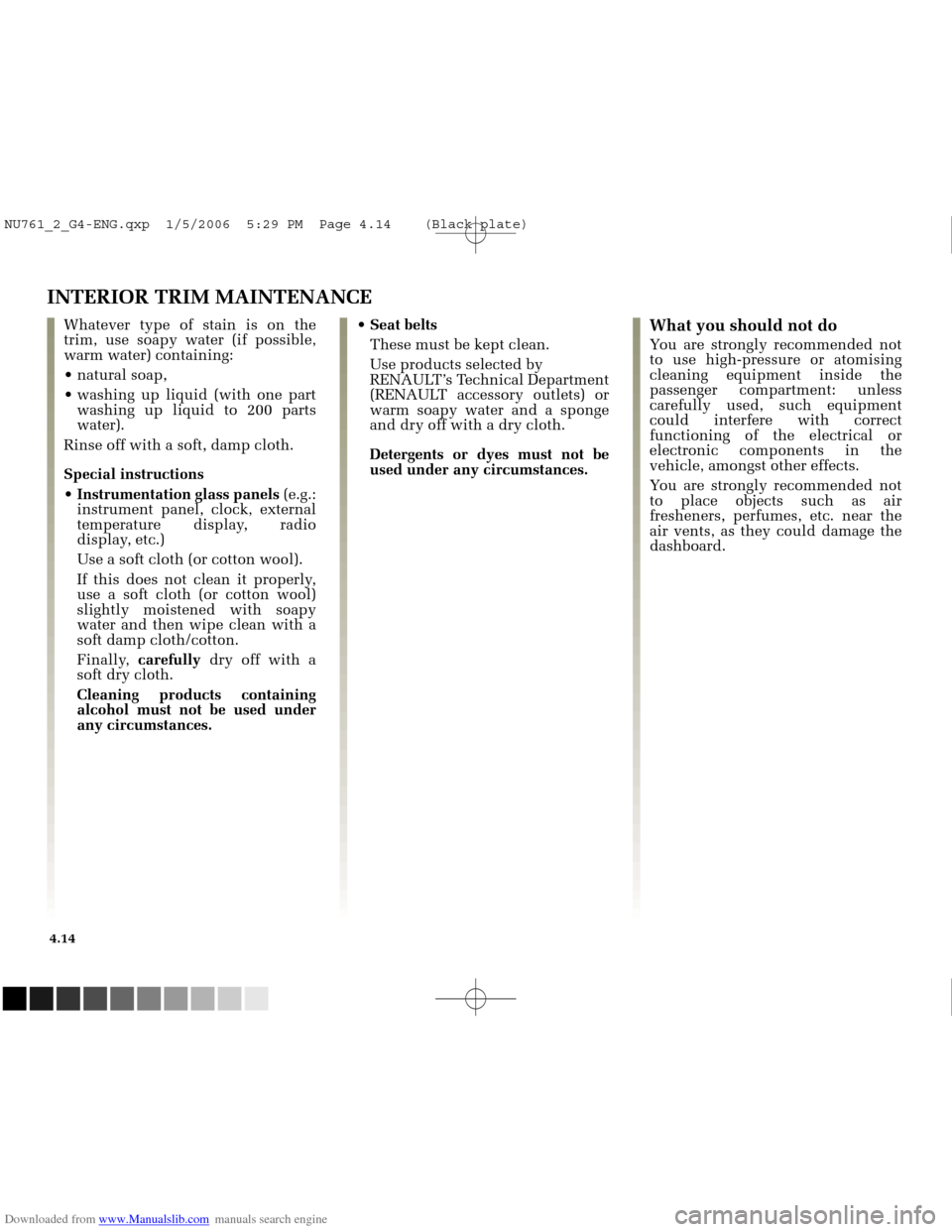
Downloaded from www.Manualslib.com manuals search engine
NU761_2_G4-FRA.qxd 14/11/05 10:11 Page 4.14
4.14
INTERIOR TRIM MAINTENANCE
Whatever type of stain is on the
trim, use soapy water (if possible,
warm water) containing:
natural soap,
washing up liquid (with one partwashing up liquid to 200 parts
water).
Rinse off with a soft, damp cloth.
Special instructions
Instrumentation glass panels (e.g.:
instrument panel, clock, external
temperature display, radio
display, etc.)
Use a soft cloth (or cotton wool).
If this does not clean it properly,
use a soft cloth (or cotton wool)
slightly moistened with soapy
water and then wipe clean with a
soft damp cloth/cotton.
Finally, carefully dry off with a
soft dry cloth.
Cleaning products containing
alcohol must not be used under
any circumstances. Seat belts
These must be kept clean.
Use products selected by
RENAULT’s Technical Department
(RENAULT accessory outlets) or
warm soapy water and a sponge
and dry off with a dry cloth.
Detergents or dyes must not be
used under any circumstances.What you should not do
You are strongly recommended not
to use high-pressure or atomising
cleaning equipment inside the
passenger compartment: unless
carefully used, such equipment
could interfere with correct
functioning of the electrical or
electronic components in the
vehicle, amongst other effects.
You are strongly recommended not
to place objects such as air
fresheners, perfumes, etc. near the
air vents, as they could damage the
dashboard.
NU761_2_G4-ENG.qxp 1/5/2006 5:29 PM Page 4.14 (Black plate)
Page 189 of 250
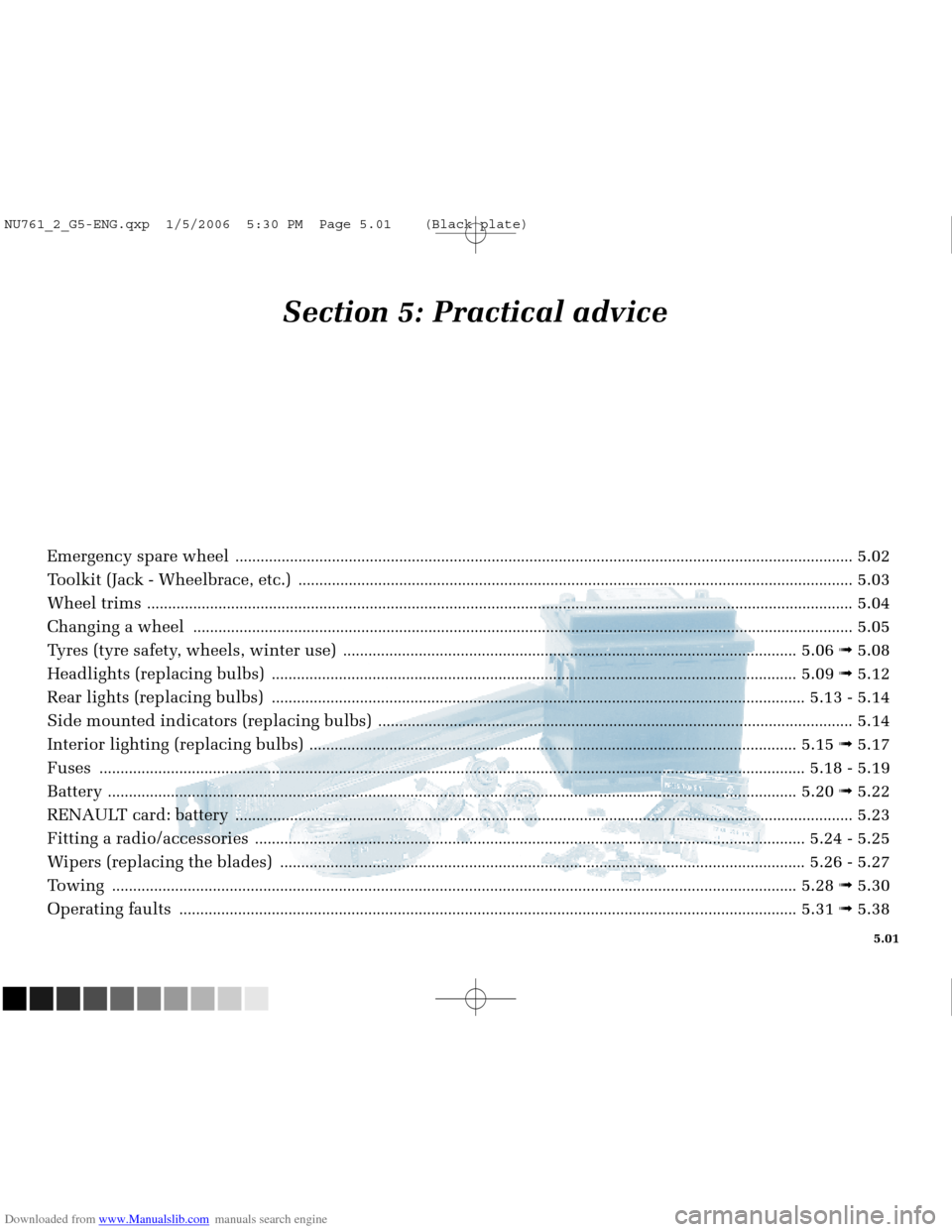
Downloaded from www.Manualslib.com manuals search engine
NU761_2_G5-FRA.qxd 4/11/05 11:09 Page 5.01
Section 5: Practical advice
Emergency spare wheel ........................................................................\
...........................................................................5.02
Toolkit (Jack - Wheelbrace, etc.)
........................................................................\
....................................................... .....5.03
Wheel trims
........................................................................\
....................................................... .........................................5.04
Changing a wheel
........................................................................\
....................................................... ..............................5.05
Tyres (tyre safety, wheels, winter use)
........................................................................\
....................................5.06 ➟5.08
Headlights (replacing bulbs)
........................................................................\
.....................................................5.09 ➟5.12
Rear lights (replacing bulbs)
........................................................................\
.......................................................5.13 - 5.14
Side mounted indicators (replacing bulbs)
........................................................................\
.........................................5.14
Interior lighting (replacing bulbs)
........................................................................\
............................................5.15 ➟5.17
Fuses
........................................................................\
....................................................... .........................................5.18 - 5.19
Battery
........................................................................\
....................................................... .....................................5.20 ➟5.22
RENAULT card: battery
........................................................................\
....................................................... ....................5.23
Fitting a radio/accessories
........................................................................\
....................................................... ....5.24 - 5.25
Wipers (replacing the blades)
........................................................................\
.....................................................5.26 - 5.27
Towing
........................................................................\
....................................................... ....................................5.28 ➟5.30
Operating faults
........................................................................\
....................................................... ....................5.31 ➟5.38
5.01
NU761_2_G5-ENG.qxp 1/5/2006 5:30 PM Page 5.01 (Black plate)
Page 190 of 250
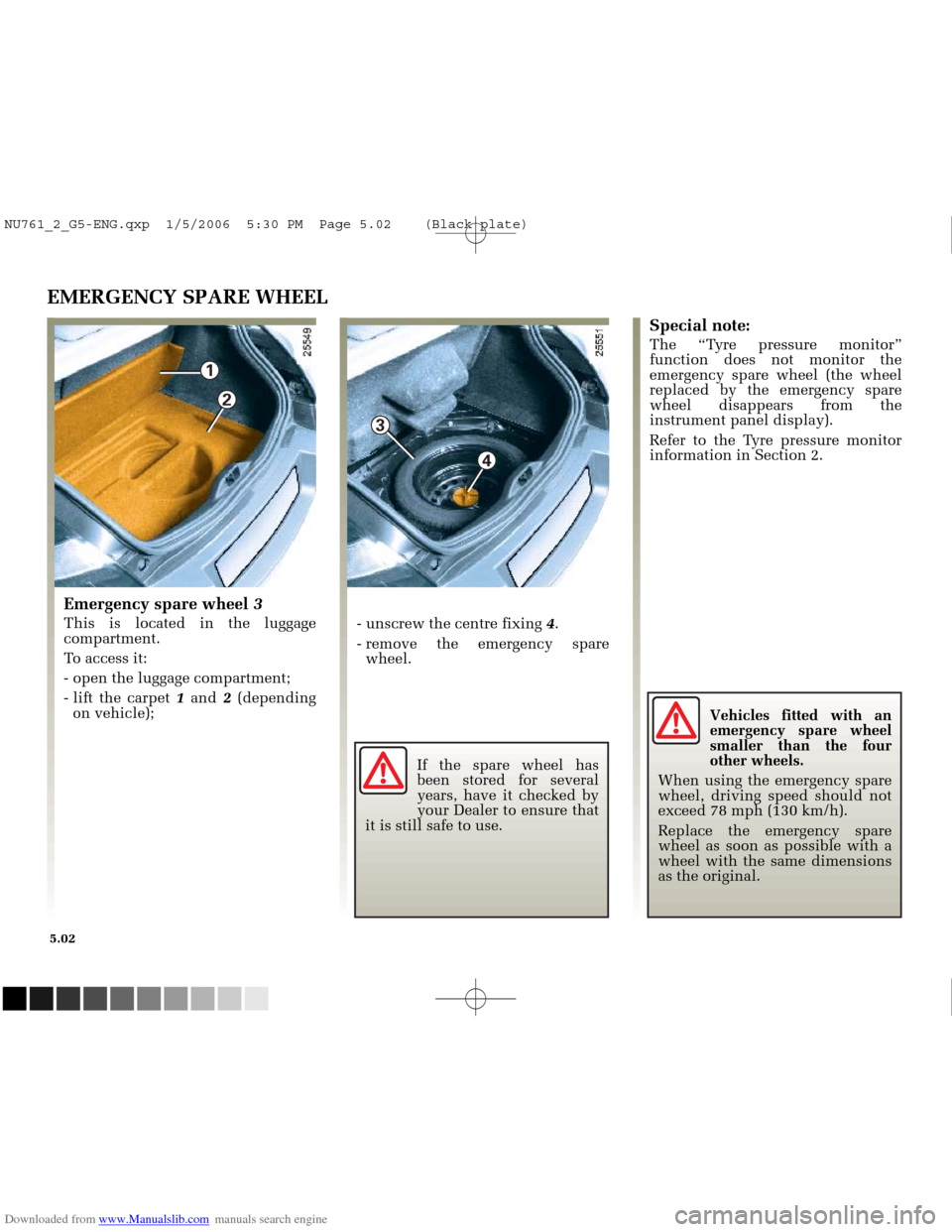
Downloaded from www.Manualslib.com manuals search engine
1
4
3
2
NU761_2_G5-FRA.qxd 4/11/05 11:09 Page 5.02
5.02
EMERGENCY SPARE WHEEL
Emergency spare wheel 3
This is located in the luggage
compartment.
To access it:
- open the luggage compartment;
- lift the carpet 1and 2(depending
on vehicle);
Special note:
The “Tyre pressure monitor”
function does not monitor the
emergency spare wheel (the wheel
replaced by the emergency spare
wheel disappears from the
instrument panel display).
Refer to the Tyre pressure monitor
information in Section 2.
- unscrew the centre fixing 4.
- remove the emergency spare wheel.
If the spare wheel has
been stored for several
years, have it checked by
your Dealer to ensure that
it is still safe to use. Vehicles fitted with an
emergency spare wheel
smaller than the four
other wheels.
When using the emergency spare
wheel, driving speed should not
exceed 78 mph (130 km/h).
Replace the emergency spare
wheel as soon as possible with a
wheel with the same dimensions
as the original.
NU761_2_G5-ENG.qxp 1/5/2006 5:30 PM Page 5.02 (Black plate)